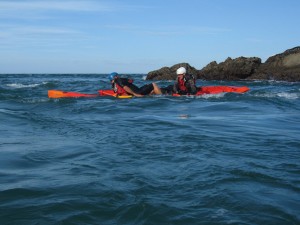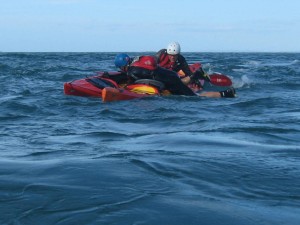3 star for sit-on-top kayaks part 3: Sit on top rescues and rock gardens
Andy and Keith’s paddle skills were rapidly improving. So much so that in spite of a lot of ‘playing’ in la Tour they did not fall in. It was time to cure that with a bit of self rescue and assisted sit on top kayak rescue practice.
On average their self rescues took no more than 40 seconds. This demonstrates just how important it is to practice self rescue techniques in realistic (but safe) conditions.
You’ll notice Andy swtiched to an Ocean kayak Scupper Pro. To be perfectly honest his Tarpon would not have been up to some of the skills work we were doing at this stage.
Andy has since gone and bought a Scupper Pro!
If you plan to take the BCU 3 star asessment with a Sit-on-top kayak your choice of kayak is a key factor. We’ve a selection of Sit-on-top designs available so you can select the best for the task.
A good thing about la tour is that the tide stream fades away after a while to enable you to go and pick up the pieces if it your rescue skills do not work out as fast as planned
Sit-on-top rescue tips
Know which side you are best getting back on board from.
Grab hold of the kayak (and paddle if not on a leash) quickly.
If you use a paddle leash make sure it is not under the kayak after you get back on board as trying to retrieve it can be tricky.
Wear a helmet when practising rescues.
Watch out for gear in the PFD pockets snagging as you climb on board.
A strong kick of the legs to propel yourself on board is key.
The rescue kayaker needs to be very positive in manoeuvring skills to avoid hitting the swimmer and avoid falling in.
It is vital the rescuer leans well over the kayak to provide stability.
Practice, practice, practice!
Note how the paddle leash is put on the far side of the kayak. As you can hear Andy was a bit surprised that keith was happy to head into the main stream to self resuce!
Moving water skills
Conditions change. Even on a short trip it can be very different around a headland or as you head out of the bay.
Get some training in more challenging waters in order to know your limits.
Far to often sit on top kayakers wander into areas that will give them a scare because they have no prior experience or reference points to base decisions on.
It’s far better to have a bit of a challenge and know your limits with a bit of training than to have little idea that you are moving beyond your comfort zone and then discover you have no skills to get you out of trouble.


